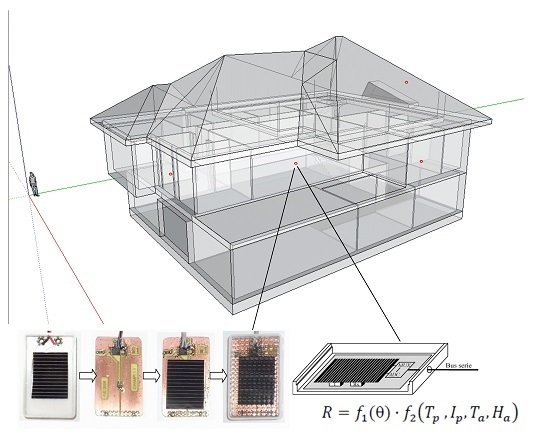Modeling and Experimental Validation of a Low-Cost Radiation Sensor Based on the Photovoltaic Effect for Building Applications
Abstract
:1. Introduction
2. Background: The Use of Solar Cells for Irradiation Assessment
3. Materials and Methods
3.1. Devices
3.2. Testing Section
3.3. Thermal Model and Response Fitting
- (a)
- It is necessary calculate the temporal derivative of cell temperature. As the temperature can be measured at each moment, its derivative can be approached.
- (b)
- Electric current is provided by the cell through the shunt resistance.
- (c)
- Ambient conditions (temperature, humidity, irradiance) can be measured.
- (d)
- Finally, there exists a nonlinear relationship between irradiance R and the other variables by the transmittance-absorptance product.
4. Results and Discussion
5. Conclusions
Acknowledgments
Author Contributions
Conflicts of Interest
References
- Key World Energy Statistics 2015; International Energy Agency: Paris, France, 2015.
- Energy Performance Building Directive. 2002. Available online: http://www.bre.co.uk/filelibrary/Scotland/Energy_Performance_of_Buildings_Directive_(EPBD).pdf (accessed on 8 November 2016).
- Energy Performance Building Directive. 2010. Available online: https://umanitoba.ca/faculties/engineering/departments/ce2p2e/alternative_village/media/1_eceee_buildings_policybrief2010_rev.pdf (accessed on 8 November 2016).
- Karimpour, M.; Belusko, M.; Xing, K.; Bruno, F. Minimising the life cycle energy of buildings: Review and analysis. Build. Environ. 2014, 73, 106–114. [Google Scholar] [CrossRef]
- Dwaikat, L.N.; Ali, K.N. Measuring the actual energy cost performance of green buildings: A test of the earned value management approach. Energies 2016, 9. [Google Scholar] [CrossRef]
- Vilčeková, S.; Čuláková, M.; Burdová, E.K.; Katunská, J. Energy and environmental evaluation of non-transparent constructions of building envelope for wooden houses. Energies 2015, 8, 11047–11075. [Google Scholar] [CrossRef]
- Ramesh, T.; Prakash, R.; Shukla, K. Life cycle energy analysis of buildings: An overview. Energy Build. 2010, 42, 1592–1600. [Google Scholar] [CrossRef]
- Sartori, I.; Hestnes, A.G. Energy use in the life cycle of conventional and low-energy buildings: A review article. Energy Build. 2007, 39, 249–257. [Google Scholar] [CrossRef]
- Chan, H.-Y.; Riffat, S.B.; Zhu, J. Review of passive solar heating and cooling technologies. Renew. Sustain. Energy Rev. 2010, 14, 781–789. [Google Scholar] [CrossRef]
- Florides, G.; Tassou, S.; Kalogirou, S.; Wrobel, L. Measures used to lower building energy consumption and their cost effectiveness. Appl. Energy 2002, 73, 299–328. [Google Scholar] [CrossRef]
- Pacheco, R.; Ordóñez, J.; Martínez, G. Energy efficient design of building: A review. Renew. Sustain. Energy Rev. 2012, 16, 3559–3573. [Google Scholar] [CrossRef]
- Rakhshan, K.; Friess, W.A.; Tajerzadeh, S. Evaluating the sustainability impact of improved building insulation: A case study in the dubai residential built environment. Build. Environ. 2013, 67, 105–110. [Google Scholar] [CrossRef]
- Zhu, L.; Hurt, R.; Correia, D.; Boehm, R. Detailed energy saving performance analyses on thermal mass walls demonstrated in a zero energy house. Energy Build. 2009, 41, 303–310. [Google Scholar] [CrossRef]
- Datta, G. Effect of fixed horizontal louver shading devices on thermal perfomance of building by trnsys simulation. Renew. Energy 2001, 23, 497–507. [Google Scholar] [CrossRef]
- Palmero-Marrero, A.I.; Oliveira, A.C. Effect of louver shading devices on building energy requirements. Appl. Energy 2010, 87, 2040–2049. [Google Scholar] [CrossRef]
- Florides, G.; Kalogirou, S.; Tassou, S.; Wrobel, L. Modeling of the modern houses of cyprus and energy consumption analysis. Energy 2000, 25, 915–937. [Google Scholar] [CrossRef]
- Lee, E.S.; Tavil, A. Energy and visual comfort performance of electrochromic windows with overhangs. Build. Environ. 2007, 42, 2439–2449. [Google Scholar] [CrossRef]
- Radhi, H.; Eltrapolsi, A.; Sharples, S. Will energy regulations in the gulf states make buildings more comfortable—A scoping study of residential buildings. Appl. Energy 2009, 86, 2531–2539. [Google Scholar] [CrossRef]
- Simmler, H.; Binder, B. Experimental and numerical determination of the total solar energy transmittance of glazing with venetian blind shading. Build. Environ. 2008, 43, 197–204. [Google Scholar] [CrossRef]
- Tzempelikos, A.; Athienitis, A.K. The impact of shading design and control on building cooling and lighting demand. Sol. Energy 2007, 81, 369–382. [Google Scholar] [CrossRef]
- León, Á.L.; Domínguez, S.; Campano, M.A.; Ramírez-Balas, C. Reducing the energy demand of multi-dwelling units in a mediterranean climate using solar protection elements. Energies 2012, 5, 3398–3424. [Google Scholar] [CrossRef]
- Gratia, E.; de Herde, A. The most efficient position of shading devices in a double-skin facade. Energy Build. 2007, 39, 364–373. [Google Scholar] [CrossRef]
- Kim, G.; Lim, H.S.; Lim, T.S.; Schaefer, L.; Kim, J.T. Comparative advantage of an exterior shading device in thermal performance for residential buildings. Energy Build. 2012, 46, 105–111. [Google Scholar] [CrossRef]
- Kim, S.-H.; Shin, K.-J.; Choi, B.-E.; Jo, J.-H.; Cho, S.; Cho, Y.-H. A study on the variation of heating and cooling load according to the use of horizontal shading and venetian blinds in office buildings in korea. Energies 2015, 8, 1487–1504. [Google Scholar] [CrossRef]
- Ashrae Handbook e Fundamentals, Chapter 15 (Fenestration), Ashrae (American Society of Heating, Refrigerating and Air-Conditioning Engineers); ASHRAE Inc.: Atlanta, GA, USA, 2009.
- Bellia, L.; De Falco, F.; Minichiello, F. Effects of solar shading devices on energy requirements of standalone office buildings for italian climates. Appl. Therm. Eng. 2013, 54, 190–201. [Google Scholar] [CrossRef]
- Synnefa, A.; Santamouris, M.; Livada, I. A study of the thermal performance of reflective coatings for the urban environment. Sol. Energy 2006, 80, 968–981. [Google Scholar] [CrossRef]
- Bellia, L.; Marino, C.; Minichiello, F.; Pedace, A. An overview on solar shading systems for buildings. Energy Procedia 2014, 62, 309–317. [Google Scholar] [CrossRef]
- Huang, K.-T.; Liu, K.F.-R.; Liang, H.-H. Design and energy performance of a buoyancy driven exterior shading device for building application in taiwan. Energies 2015, 8, 2358–2380. [Google Scholar] [CrossRef]
- Nielsen, M.V.; Svendsen, S.; Jensen, L.B. Quantifying the potential of automated dynamic solar shading in office buildings through integrated simulations of energy and daylight. Sol. Energy 2011, 85, 757–768. [Google Scholar] [CrossRef]
- Wankanapona, P.; Mistrickb, R.G. Roller shades and automatic lighting control with solar radiation control strategies. Built 2011, 1, 35–42. [Google Scholar]
- Liu, M.; Wittchen, K.B.; Heiselberg, P.K. Control strategies for intelligent glazed façade and their influence on energy and comfort performance of office buildings in denmark. Appl. Energy 2015, 145, 43–51. [Google Scholar] [CrossRef]
- Wienold, J.; Frontini, F.; Herkel, S.; Mende, S. Climate based simulation of different shading device systems for comfort and energy demand. In Proceedings of the 12th Conference of International Building Performance Simulation Association, Sydney, Australia, 14–16 November 2011.
- Da Silva, P.C.; Leal, V.; Andersen, M. Influence of shading control patterns on the energy assessment of office spaces. Energy Build. 2012, 50, 35–48. [Google Scholar] [CrossRef]
- Foster, M.; Oreszczyn, T. Occupant control of passive systems: The use of venetian blinds. Build. Environ. 2001, 36, 149–155. [Google Scholar] [CrossRef]
- Hoffmann, S.; Lee, E.S.; McNeil, A.; Fernandes, L.; Vidanovic, D.; Thanachareonkit, A. Balancing daylight, glare, and energy-efficiency goals: An evaluation of exterior coplanar shading systems using complex fenestration modeling tools. Energy Build. 2016, 112, 279–298. [Google Scholar] [CrossRef]
- Shen, H.; Tzempelikos, A. Daylighting and energy analysis of private offices with automated interior roller shades. Sol. Energy 2012, 86, 681–704. [Google Scholar] [CrossRef]
- Van Moeseke, G.; Bruyère, I.; de Herde, A. Impact of control rules on the efficiency of shading devices and free cooling for office buildings. Build. Environ. 2007, 42, 784–793. [Google Scholar] [CrossRef]
- Athienitis, A.; Tzempelikos, A. A methodology for simulation of daylight room illuminance distribution and light dimming for a room with a controlled shading device. Sol. Energy 2002, 72, 271–281. [Google Scholar] [CrossRef]
- Lollini, R.; Danza, L.; Meroni, I. Energy efficiency of a dynamic glazing system. Sol. Energy 2010, 84, 526–537. [Google Scholar] [CrossRef]
- Koo, S.Y.; Yeo, M.S.; Kim, K.W. Automated blind control to maximize the benefits of daylight in buildings. Build. Environ. 2010, 45, 1508–1520. [Google Scholar] [CrossRef]
- Aste, N.; Compostella, J.; Mazzon, M. Comparative energy and economic performance analysis of an electrochromic window and automated external venetian blind. Energy Procedia 2012, 30, 404–413. [Google Scholar] [CrossRef]
- Lee, E.S.; DiBartolomeo, D.L.; Rubinstein, F.M.; Selkowitz, S.E. Low-cost networking for dynamic window systems. Energy Build. 2004, 36, 503–513. [Google Scholar] [CrossRef]
- Muñoz-García, M.A.; Melado-Herreros, A.; Balenzategui, J.L.; Barrerio, P. Low-cost irradiance sensors for irradiation assessments inside tree canopies. Sol. Energy 2014, 103, 143–153. [Google Scholar] [CrossRef] [Green Version]
- Plesz, B.; Földváry, Á.; Bándy, E. Low cost solar irradiation sensor and its thermal behaviour. Microelectr. J. 2011, 42, 594–600. [Google Scholar] [CrossRef]
- Dussault, J.-M.; Kohler, C.; Goudey, H.; Hart, R.; Gosselin, L.; Selkowitz, S.E. Development and assessment of a low cost sensor for solar heat flux measurements in buildings. Sol. Energy 2015, 122, 795–803. [Google Scholar] [CrossRef]
- King, D.L.; Boyson, W.E.; Hansen, B.R. Improved Accuracy for Low-Cost Solar Irradiance Sensors; Sandia National Labs.: Albuquerque, NM, USA, 1997. [Google Scholar]
- Syed, A.; Izquierdo, M.; Rodríguez, P.; Maidment, G.; Missenden, J.; Lecuona, A.; Tozer, R. A novel experimental investigation of a solar cooling system in madrid. Int. J. Refrig. 2005, 28, 859–871. [Google Scholar] [CrossRef]
- Vigni, V.L.; Manna, D.L.; Sanseverino, E.R.; di Dio, V.; Romano, P.; Di Buono, P.; Pinto, M.; Miceli, R.; Giaconia, C. Proof of concept of an irradiance estimation system for reconfigurable photovoltaic arrays. Energies 2015, 8, 6641–6657. [Google Scholar] [CrossRef] [Green Version]
- Seyedmahmoudian, M.; Mekhilef, S.; Rahmani, R.; Yusof, R.; Renani, E.T. Analytical modeling of partially shaded photovoltaic systems. Energies 2013, 6, 128–144. [Google Scholar] [CrossRef] [Green Version]
- Gómez-Moreno, A.; Casanova Peláez, P.; Díaz-Garrido, F.; Palomar-Carnicero, J.; López-García, R.; Cruz-Peragón, F. Response fitting in low-cost radiation sensors. In Proceedings of the International Conference on Renewable Energies and Power Quality (ICREPQ’10), Granada, Spain, 23–25 March 2010.
- Goswami, D.Y.; Kreith, F.; Kreider, J.F. Principles of Solar Engineering, 2nd ed.; CRC Press: Boca Raton, FL, USA, 2000. [Google Scholar]
- Myers, D.R. Solar radiation modeling and measurements for renewable energy applications: Data and model quality. Energy 2005, 30, 1517–1531. [Google Scholar] [CrossRef]
- SP Lite2 Pyranometer. Available online: http://www.kippzonen.com/ProductGroup/3/Pyranometers (accessed on 5 May 2016).
- Duffie, J.A.; Beckman, W.A. Solar Engineering of Thermal Processes, 4th ed.; Wiley: New York, NY, USA, 2013. [Google Scholar]
- Krauter, S.; Hanitsch, R. Actual optical and thermal performance of PV-modules. Sol. Energ. Mater. Sol. Cells 1996, 41–42, 557–574. [Google Scholar] [CrossRef]
- Friesen, G.; Zaaiman, W.; Bishop, J. Temperature behaviour of photovoltaic parameters. In Proceedings of the Second World Conference and Exhibition on Photovoltaic Solar Energy Conversion, Wien, Austria, 6–10 July 1998.
- El-Adawi, M.; Al-Nuaim, I. The temperature functional dependence of voc for a solar cell in relation to its efficiency new approach. Desalination 2007, 209, 91–96. [Google Scholar] [CrossRef]
- Technical Data Sheet, Thermokey. Avalaible online: http://www.thermokey.it/Power_line_Dry_Coolers.aspx (accessed on 21 January 2016).
- Lundqvist, M.; Helmke, C.; Ossenbrink, H. ESTI-LOG PV plant monitoring system. Sol. Energ. Mater. Sol. Cells 1997, 47, 289–294. [Google Scholar] [CrossRef]
- Alados-Arboledas, L.; Batlles, F.; Olmo, F. Solar radiation resource assessment by means of silicon cells. Sol. Energy 1995, 54, 183–191. [Google Scholar] [CrossRef]
- Anis, W.; Mertens, R.; Van Overstraeten, R. Calculation of solar cell operating temperature in a flat plate PV array. In Proceedings of the Photovoltaic Solar Energy Conference, Anaheim, CA, USA, 5–9 June 1984; pp. 520–524.
- Jones, A.; Underwood, C. A thermal model for photovoltaic systems. Sol. Energy 2001, 70, 349–359. [Google Scholar] [CrossRef]
- Knaup, W. Thermal description of photovoltaic modules. In Proceedings of the 11th E.C. PV Solar Energy Conference, Montreux, Switzerland, 12–16 October 1992; pp. 1344–1347.
- Wilshaw, A.R.; Pearsall, N.M.; Hill, R. Installation and operation of the first city centre PV monitoring station in the united kingdom. Sol. Energy 1997, 59, 19–26. [Google Scholar] [CrossRef]
- Standard Iec 60891 ed 2, 2009. Photovoltaic Devices-Procedures for Temperature and Irradiance Corrections to Measured iv Characteristics; International Electrotechnical Commission, IEC Central Office: Geneva, Switzerland, 1987.
- Moran, M.J.; Shapiro, H.N.; Boettner, D.D.; Bailey, M.B. Fundamentals of Engineering Thermodynamics, 7th ed.; John Wiley & Sons: Hoboken, NJ, USA, 2010. [Google Scholar]
- Bergman, T.L.; Incropera, F.P.; Lavine, A.S. Fundamentals of Heat and Mass Transfer; John Wiley & Sons: Hoboken, NJ, USA, 2011. [Google Scholar]
- Muneer, T.; Younes, S.; Munawwar, S. Discourses on solar radiation modeling. Renew. Sustain. Energ. Rev. 2007, 11, 551–602. [Google Scholar] [CrossRef]
- Gill, P.E.; Murray, W.; Wright, M.H. Practical Optimization; Academic Press: San Diego, CA, USA, 1997. [Google Scholar]
- Canavos, G.C.; Koutrouvelis, I.A. An Introduction to the Design & Analysis of Experiments; Pearson/Prentice Hall: Upper Saddle River, NJ, USA, 2009. [Google Scholar]
- Alados-Arboledas, L.; Castro-D, Y.; Bathes, F.; Jimenez, J. Matching silicon cells and thermopile pyranometers responses. In Proceedings of the II World Renewable Energy Congress, Istanbul, Turkey, 28–30 June 2012; pp. 2736–2740.
- Suehrcke, H.; Ling, C.; McCormick, P. The dynamic response of instruments measuring instantaneous solar radiation. Sol. Energy 1990, 44, 145–148. [Google Scholar] [CrossRef]
- Hydeman, M.; Webb, N.; Sreedharan, P.; Blanc, S. Development and testing of a reformulated regression-based electric chiller model/discussion. ASHRAE Trans. 2002, 108, 1118. [Google Scholar]
- Jiang, W.; Reddy, T.A. Reevaluation of the gordon-ng performance models for water-cooled chillers. ASHRAE Trans. 2003, 109, 272–287. [Google Scholar]
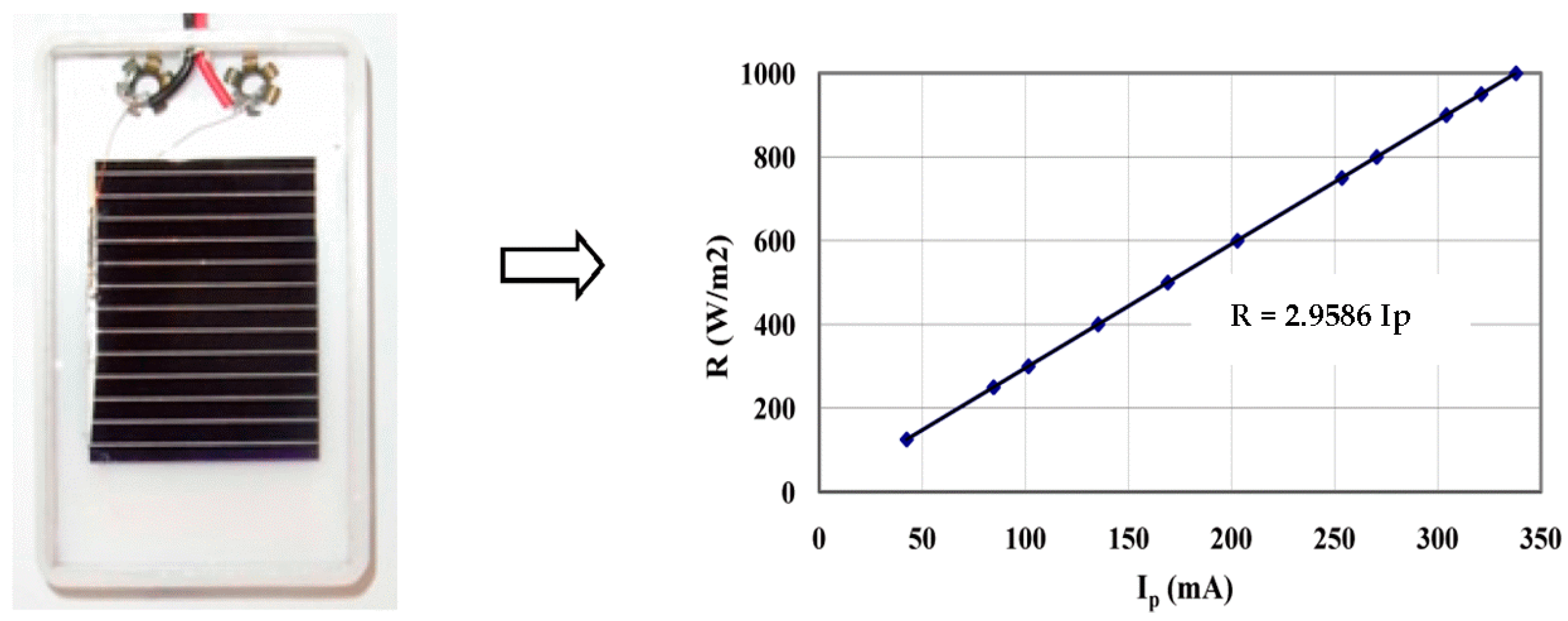

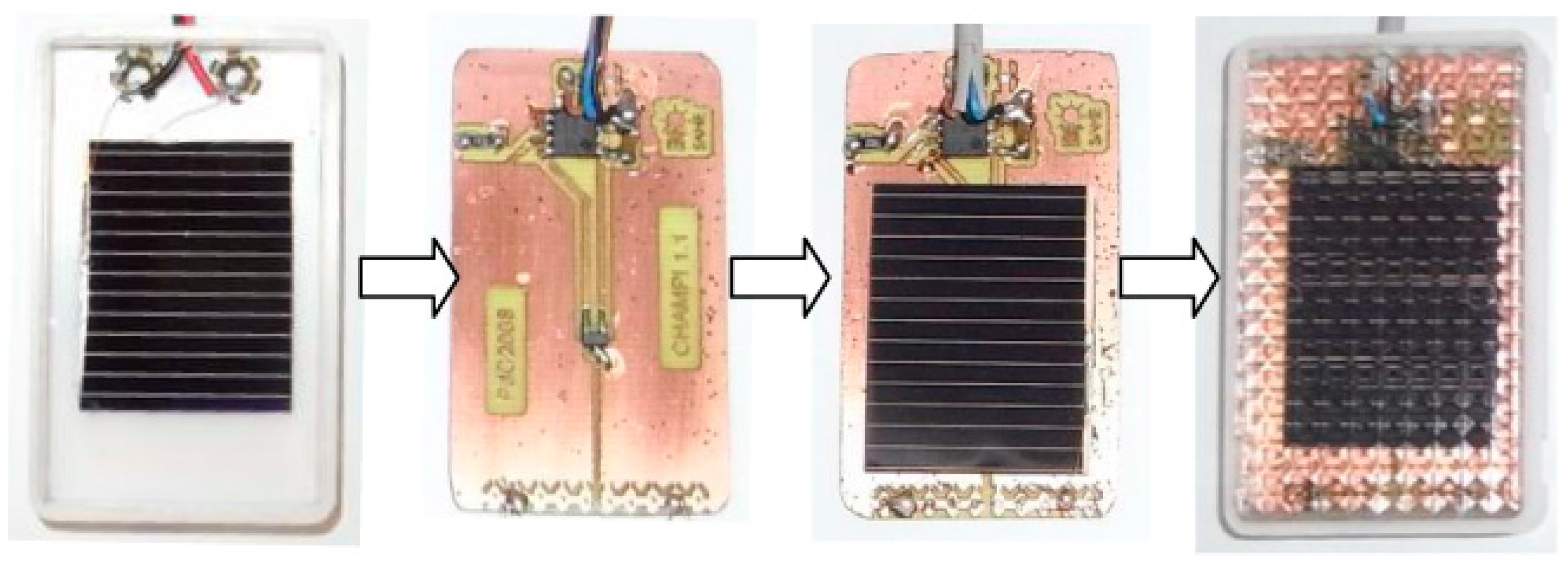


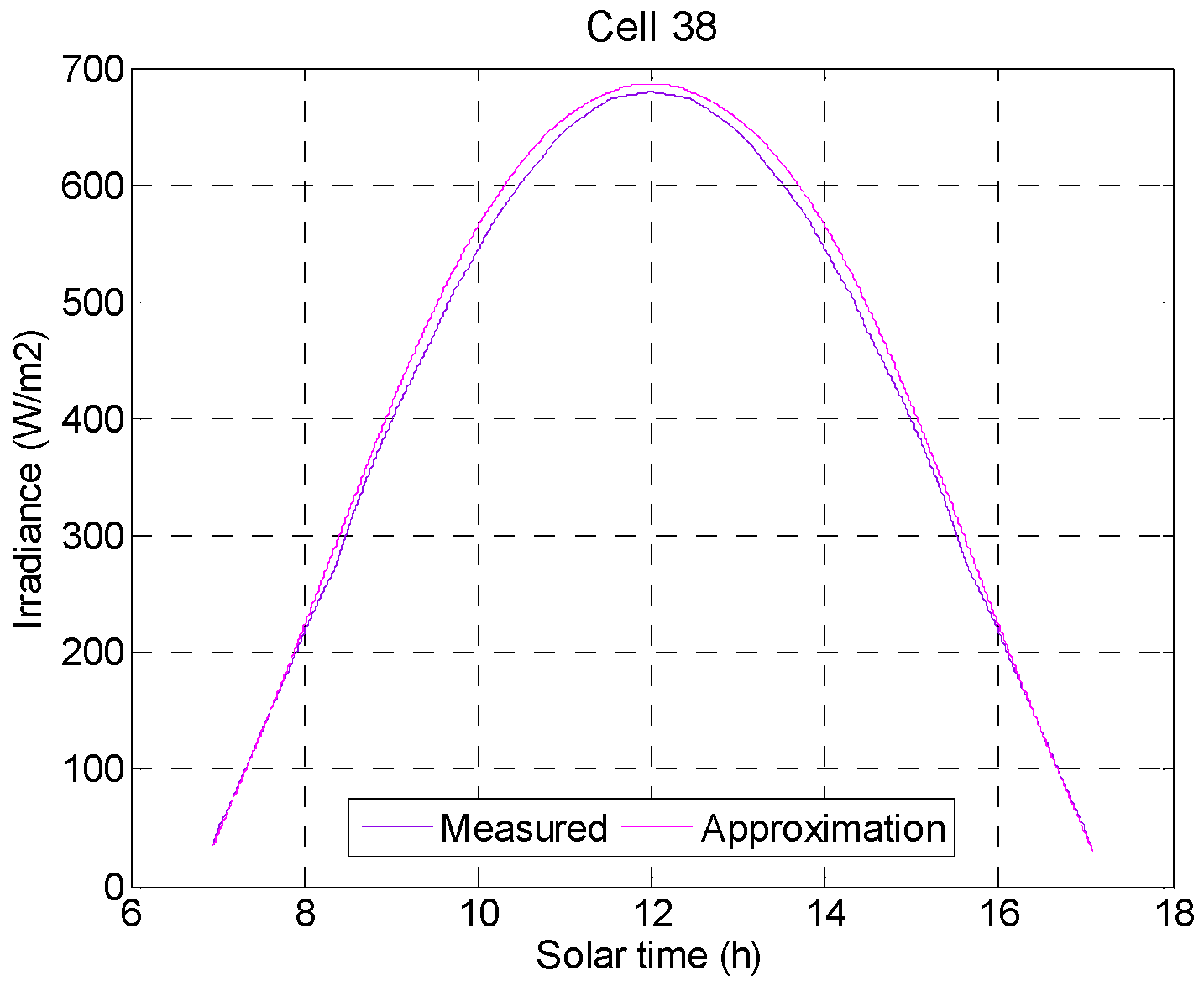
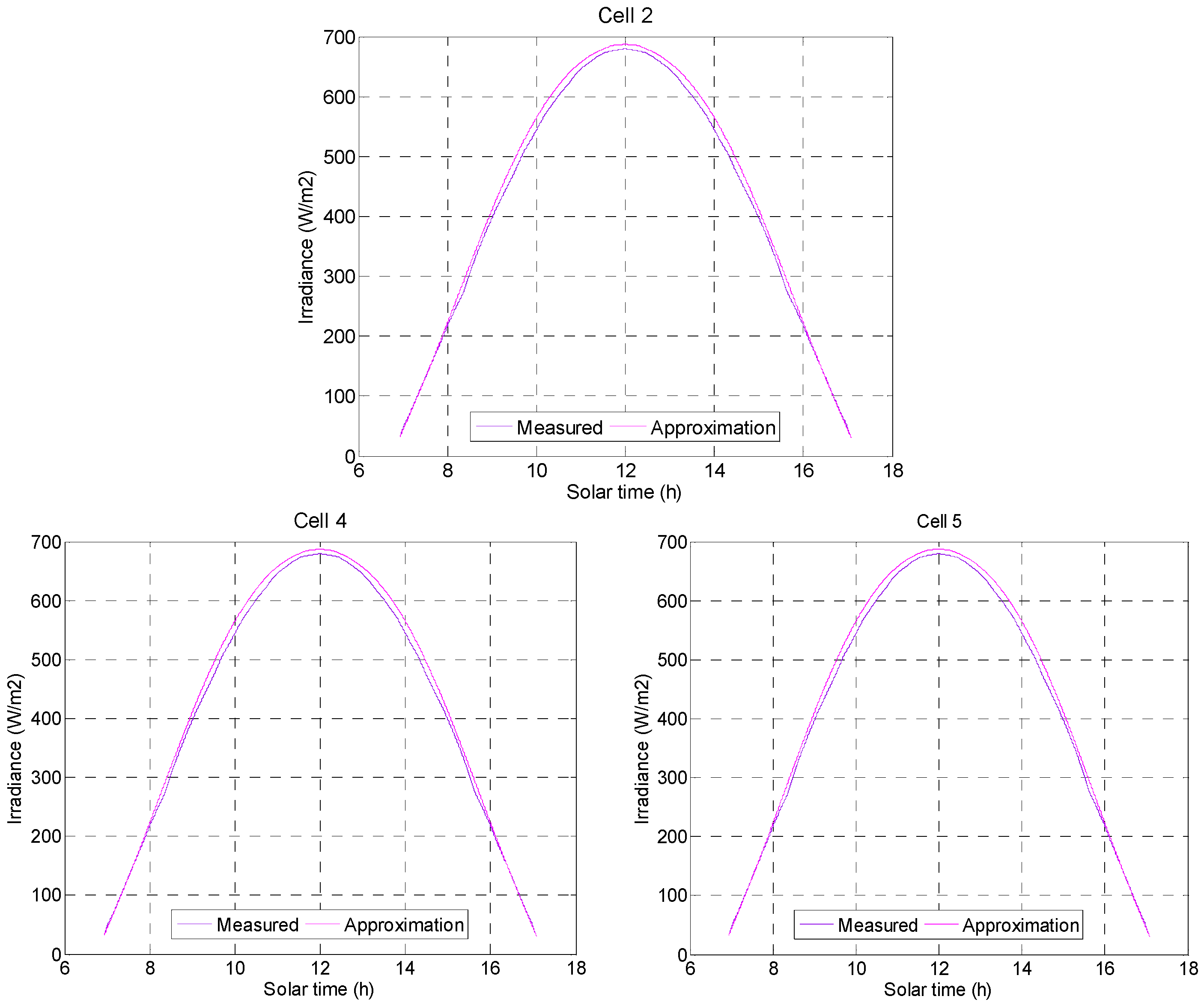

| Test No. (GMT) | 1 (8 GMT) | 2 (10 GMT) | 3 (12 GMT) | 4 (13 GMT) |
|---|---|---|---|---|
| R (W/m2) | 100 | 432 | 605 | 602 |
| Ta (°C) | 3 | 8 | 11 | 12.5 |
| Hr (%) | 76 | 60 | 50 | 35 |
| G1 | G2 | G3 | G4 | G5 |
| 0.1015893631615 | −0.1116521865633 | −0.2254041394135 | −0.2211817924397 | −0.1027093578943 |
| G6 | G7 | G8 | G9 | G10 |
| 0.0778389607671 | 0.1794071521243 | −0.0836746000453 | 0.9642344205781 | −0.0000011527335 |
| G11 | G12 | G13 | G14 | - |
| −0.0023890197853 | −0.0000455042498 | −0.0847262359220 | 0.0002663236168 | - |
© 2016 by the authors; licensee MDPI, Basel, Switzerland. This article is an open access article distributed under the terms and conditions of the Creative Commons Attribution (CC-BY) license (http://creativecommons.org/licenses/by/4.0/).
Share and Cite
Gómez-Moreno, Á.; Casanova-Peláez, P.J.; Palomar-Carnicero, J.M.; Cruz-Peragón, F. Modeling and Experimental Validation of a Low-Cost Radiation Sensor Based on the Photovoltaic Effect for Building Applications. Energies 2016, 9, 926. https://doi.org/10.3390/en9110926
Gómez-Moreno Á, Casanova-Peláez PJ, Palomar-Carnicero JM, Cruz-Peragón F. Modeling and Experimental Validation of a Low-Cost Radiation Sensor Based on the Photovoltaic Effect for Building Applications. Energies. 2016; 9(11):926. https://doi.org/10.3390/en9110926
Chicago/Turabian StyleGómez-Moreno, Ángel, Pedro José Casanova-Peláez, José Manuel Palomar-Carnicero, and Fernando Cruz-Peragón. 2016. "Modeling and Experimental Validation of a Low-Cost Radiation Sensor Based on the Photovoltaic Effect for Building Applications" Energies 9, no. 11: 926. https://doi.org/10.3390/en9110926




